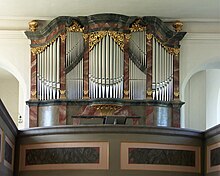Höchsterwünschtes Freudenfest, BWV 194
|
Höchsterwünschtes Freudenfest BWV 194 |
|
|---|---|
| Sacred cantata by J. S. Bach | |

The organ at Störmthal, where the cantata was first performed
|
|
| Related | based on BWV 194a |
| Occasion | Inauguration of church and organ |
| Performed | 2 November 1723: Störmthal |
| Movements | 6 |
| Chorale |
|
| Vocal |
|
| Instrumental |
|
Höchsterwünschtes Freudenfest (Most highly desired festival of joy),BWV 194, is a church cantata by Johann Sebastian Bach. He composed it in Leipzig for dedication of the church and organ at Störmthal on 2 November 1723.
The cantata text was written by an anonymous poet, including two stanzas of Johann Heermann's hymn "Treuer Gott, ich muß dir klagen" (1630) and two stanzas of Paul Gerhardt's "Wach auf, mein Herz, und singe" (1647). Bach used an earlier secular cantata as a base for a structure in two parts of six movements each, beginning with an extended choral movement and concluding both parts with chorale stanzas. The inner movements are alternating recitatives and arias. The chorales are the only movements which were certainly newly composed for the occasion. Bach scored the work for three vocal soloists, a four-part choir and a Baroque instrumental ensemble of three oboes, bassoon, strings and continuo. After the first performance in Störmthal, Bach performed the cantata again in Leipzig for Trinity Sunday, first on 4 June 1724, a shortened version in 1726, and the complete version in 1731.
The first known performance of the cantata was at Störmthal, a village near Leipzig. The church there had been rebuilt, and a new organ been built on a commission by Statz Friedrich von Fullen. The organ was an early work by Zacharias Hildebrandt. Von Fullen requested an approval of the instrument from Johann Sebastian Bach, who was then Thomaskantor in Leipzig. Bach was satisfied and composed this cantata for the dedication service for the church and the organ on 2 November 1723. The text deals with the inauguration of the church. The organ has no solo function in the cantata.
...
Wikipedia
